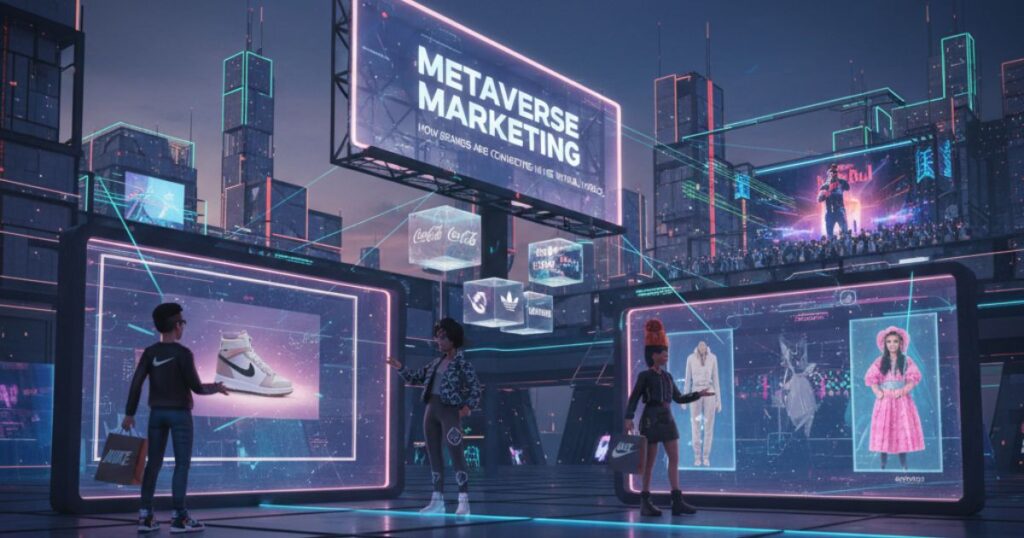The rise of the metaverse is changing how brands connect with customers. Traditional marketing is evolving as businesses explore virtual spaces where users can interact, socialize, and shop. Metaverse marketing lets brands engage audiences through immersive experiences, gamified campaigns, and augmented reality, creating stronger connections and deeper brand loyalty.
In these digital worlds, users participate as avatars, explore branded spaces, and interact with products in real time. Brands can host virtual events, launch digital collectibles, and use interactive advertising to guide customers along their journey. With omnichannel engagement across VR platforms, AR apps, and social metaverse environments, businesses can reach audiences in new, exciting ways.
In this guide, we’ll explore what metaverse marketing is, why it matters, how brands are using it, and strategies to help your business succeed in this evolving digital landscape.
What Is Metaverse Marketing?
Metaverse marketing is a strategy where brands promote products, services, and experiences within virtual environments. These digital spaces can include virtual reality (VR) worlds, augmented reality (AR) overlays, gaming platforms, and social virtual spaces. Users interact in real time through avatars, creating opportunities for personalized and interactive marketing.
Unlike traditional ads, metaverse marketing focuses on immersive engagement, interactive experiences, and digital storytelling. Brands use tools like VR experiences, AR filters, in-game items, and virtual events to connect with audiences naturally. By blending entertainment and marketing, companies can reach users in environments where they are fully engaged.
Why Metaverse Marketing Matters
The metaverse is not just a trend—it represents a shift in how people experience digital content. Here’s why it matters for brands:
1. Increased Engagement
Traditional digital ads are often ignored, but immersive experiences in the metaverse capture attention. Users actively participate in events, games, and simulations, leading to higher engagement.
2. Personalized Customer Experiences
Brands can tailor virtual experiences based on user preferences, avatars, and behaviors. Personalized interactions in virtual spaces make customers feel seen and valued.
3. New Revenue Opportunities
Digital goods, virtual real estate, NFTs, and branded items open new revenue streams. Metaverse marketing allows brands to monetize experiences creatively.
4. Stronger Brand Loyalty
Brands that create enjoyable, memorable experiences foster loyalty. Users are more likely to remember brands they interact with in exciting, immersive ways.
5. Early Mover Advantage
As the metaverse is still growing, brands that establish a presence now can lead their industries and become pioneers in virtual marketing.
How Brands Use Metaverse Marketing
1. Virtual Events and Experiences
Brands host concerts, product launches, and meet-and-greets in virtual worlds. These events allow participants to explore, interact, and engage in ways traditional events cannot offer.
2. Gamified Marketing
Companies create games or challenges that feature their products or services. Gamified experiences encourage participation while subtly promoting the brand.
3. Digital Collectibles and NFTs
Non-fungible tokens (NFTs) and virtual collectibles give users unique digital items, enhancing brand connection and providing new monetization opportunities.
4. Branded Virtual Spaces
Some brands build virtual stores, showrooms, or experiences within VR worlds or social platforms. Users can browse products, interact with brand ambassadors, and participate in immersive storytelling.
5. Augmented Reality Campaigns
AR filters, interactive ads, and mobile AR experiences bring virtual elements into real-world settings, bridging the gap between physical and digital marketing.
Best Practices for Metaverse Marketing
-
Focus on Experiences, Not Just Ads
Create engaging, interactive content that users want to participate in, rather than intrusive pop-ups or banners. -
Know Your Audience
Understand the platforms your target audience uses—gaming worlds, VR apps, or social metaverse platforms—and design campaigns accordingly. -
Leverage Gamification
Incorporate games, challenges, or rewards to encourage user participation and engagement. -
Integrate Social Elements
Enable users to share experiences, invite friends, or create content, increasing reach organically. -
Ensure Accessibility
Consider device compatibility and comfort—offer experiences for both high-end VR users and mobile or desktop users. -
Use Data Responsibly
Gather insights ethically to improve experiences while respecting privacy regulations.
Examples of Metaverse Marketing in Action
-
Nike created Nikeland in Roblox, allowing users to play games and purchase virtual apparel.
-
Coca-Cola launched limited-edition NFTs and hosted virtual events to celebrate campaigns.
-
Gucci partnered with Roblox and Fortnite for avatar fashion items, creating buzz among younger audiences.
-
Samsung built a virtual showroom in Decentraland, letting users explore products interactively.
These examples show how brands can combine entertainment, community, and commerce in virtual environments to drive awareness and engagement.
Conclusion
Metaverse marketing is transforming digital marketing by offering immersive, interactive, and personalized experiences. Brands that use VR worlds, AR campaigns, gamification, and virtual events can engage customers in ways traditional advertising cannot. By creating memorable, engaging, and shareable experiences, companies can increase loyalty, boost conversions, and position themselves as innovators in the digital space.
As the metaverse continues to grow, businesses that adopt metaverse marketing strategies today will lead the way in building stronger connections with their audiences in the virtual world.
FAQs
1. What is metaverse marketing in simple words?
It’s a strategy where brands promote products and services inside virtual worlds, VR spaces, or AR apps to engage users in interactive, immersive experiences.
2. How can metaverse marketing benefit my business?
It increases engagement, strengthens brand loyalty, opens new revenue streams, and helps you stand out as an innovative leader in your industry.
3. Do I need VR equipment for metaverse marketing?
Not always. While VR enhances immersion, many metaverse platforms and AR campaigns are accessible on desktop or mobile devices.
4. What types of brands can use metaverse marketing?
Almost any brand—fashion, tech, FMCG, gaming, entertainment, or education—can leverage virtual experiences to reach audiences creatively.
5. How do I measure success in metaverse marketing?
Metrics include engagement rates, time spent in virtual experiences, social shares, NFT sales, event participation, and conversions from interactive campaigns.


